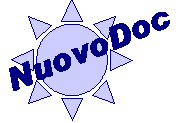 |
NuovoDoc Analysis:Model Driven Architecture |
version 0.10 last updated 2002-04-02-09:13 -0800 (pst)
Look at the basic slides and the symbols.
Look at MDA benefits and consider the impact of preservation of long-lived materials.
Where do I talk about the life-cycle issues -- look at retention periods.
How do we move up to requirements and communication with users and design of experiences and accomodation of models that are truly system models.
There are five points addressing the concerns of developers wondering about continued ODMA employment in document applications and in desktop interfaces of:
- MDA Concepts
- Model Lifecycle
- Model Realization
- System Requirements Modeling
- MDA Opportunities
- Resources and References
I am regularly told that the OMG Model-Driven Architecture is important. By colleagues in Japan.
I took the opportunity to come to OMG's roadshow sessions on MDA to find out more, and especially find out what people are looking to MDA for.
Scope of MDA. Is it really limited to Software Engineering?
How do we finesse the absence of semantics? - by using a template or pattern view that allows the semantics to be out-of-band yet the pattern has recognized application
Use UML to express information and service models (see Frankel p.4 top)
UML is more than one language and with profiling
With MOF ability to describe arbitrary language grammars, one can introduce specialized languages for particular domains
Some of that work done, more required (Frankel)
Need to look at the metadiscussion somehow.
Need a really good diagram of what is happening.
MOF just night tied in properly. Very obscure. How can this be explained, motivated, and illustrated?
What is the lifecycle of an MDA-based model? Can you model it in MDA?
What is it as a performance architecture?
Availability of Tools
- IBM WebSphere, presumably also in Eclipse
- Borland Enterprise Studio
- Rational Workbench coming
Link to Opportunities
How do I diagram the architecture of an MDA lifecycle.
Frankel illustrations of Web Services
- Business driver is exposing services over the internet, that's the real deal
- Not HTML, etc.
- The lower-level technologies are important but we'd like to be as loosely coupled to underlying technologies as possible
How are these models enacted, moved into implementations of interoperable components
What is the flow and wizardry that takes us through the from model to code, and what is the confirmation and detailing process. (Think of a Disney animation and the storyboarding of a film?)
How does that work over time?
- like the MAKE problem
- Versioning and legacy preservation techniques
- Interworking with legacy components
Deployment is an intriguing situation
How do users influence MDAs?
At what level do we interact with users?
Tying into informal models above or in conjunction with formal models, but can sketch out basic concepts and architectures. Can be formalized and machine processed in some way.
Frankel terms: Business Processes (ebXML) and Choreographies (WSCL from W3C, etc.)
- Central concept is business processes and choreographies
- Doesn't have to use UML or be formal
- Can use MOF to do a new language altogether
Mine Harmon's links and also his analysis - MDA becomes something that people will rally around, and in 2-3 years mature MDA tools emerge
MDA will be described as a market, and will grow to $2G annual market by 2005 (a doubling)
Missing is the integration with application requirements and system architecture activity
Configuration Management opportunity? In the sense of how the actual configuration of an extended system is captured and then how transformations of it can be conceived, explored, and deployed. The paper on using the ISO model as a basis for documenting configurations may be what is needed to deal with the physical as well as the recorded and the
How to embrace/explore with MDA (look at Hanson's recommendations)
Ones from the slide set.
Materials on the OMG site. Specifications
Associations and Groups that might provide higher-level material
- Vendors
- Academics
- Focused sites -- fan outlets
- Find out more about Yourdon's Cutter Consortium
Other references.
Frankels book, "OMG Press."
Jim Clark - just recently went to work for Microsoft. This is the Jim Clark?
UMM - look at p.11 lower slide UMM = UN/CEFACT Modeling Methodology
version 0.10 2002-04-02 captured during MDA presentations in Bellevue, Washington
created 2002-04-02-09:13 by orcmid
$$Author: Orcmid $
$$Date: 05-12-13 20:49 $
$$Revision: 6 $